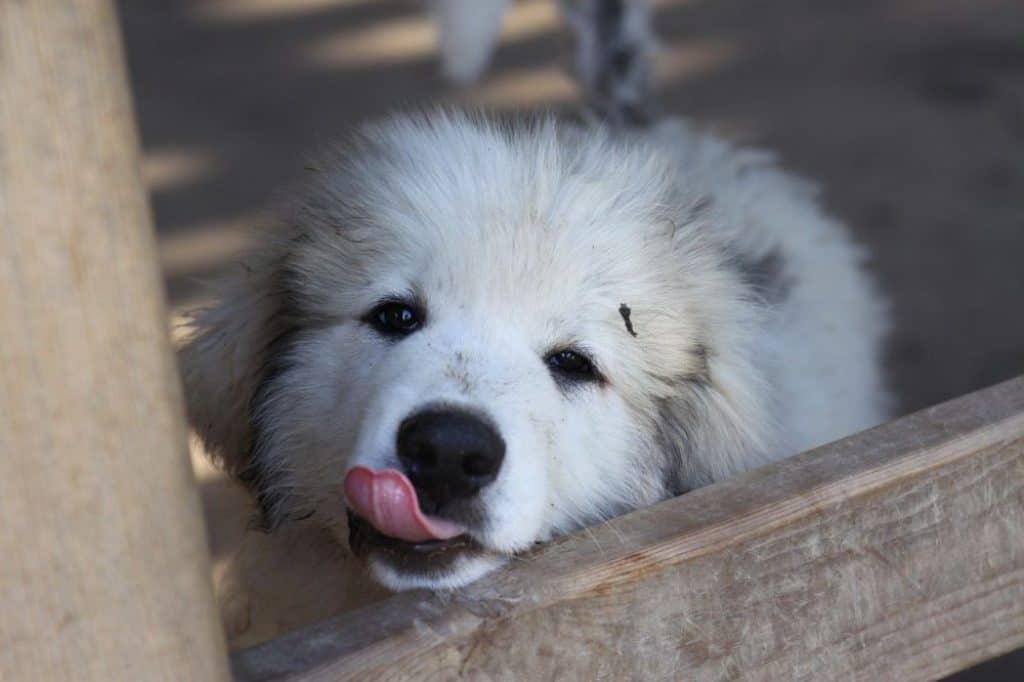Once famous as fearless mountain guardians of livestock, Great Pyrenees are nowadays mostly known as wonderful family dogs.
They’re very kind and friendly, yet extremely loyal and protective of their family.
However, these big furry balls of fun are also a big responsibility. Having a dog this huge and taking care of it is not always easy.
Big dogs have a reputation for having a shorter lifespan and requiring more care than their smaller canine counterparts.
As they’re one of the largest breeds, the Great Pyrenees lifespan is often a point of concern for potential owners.
In this article, you’ll find out how long do Great Pyrenees dogs live, what health issues they may face, and how to take care of them to help them live a healthy and long life.
[wpsm_toplist]
How Long do Great Pyrenees Dogs Live?

Like most purebreds, Great Pyrenees are relatively healthy dogs, especially for a large breed.
The expected Great Pyrenees lifespan is 10-12 years which is more than most giant-sized dogs.
Of course, how long will a specific Pyr live depends on many factors.
Some dogs live for only 7 or 8 years, while others may sneak in a few extra years and live up to 15.
Genetics play a role here as does the way the owner takes care of them. Today, the Great Pyrenees live longer than they did throughout much of their history.
Tasked with protecting the livestock, Pyrs used to spend most of their time outside, often in harsh weather and alone, without humans to take care of them.
Nowadays, most of them spend time inside the house being pampered, eating quality food, and sleeping in the warm.
All this extends their life expectancy a bit.
What Health Problems do Great Pyrenees Have?

Although they’re a reasonably healthy breed, Great Pyrenees are relatively prone to some issues you should be aware of.
Of course, this doesn’t mean that your dog will suffer from any of these problems, but it’s still something you should pay attention to.
Below are the most common health issues found Great Pyrenees may suffer from.
Elbow and Hip Dysplasia
With Great Pyrenees, both elbows and hips are at risk of dysplasia.
It’s an inherited disease where the affected joints don’t develop properly. This causes pain in joints and leads to more wear and tear.
Dysplasia can have different degrees of severity. Dogs may have mobility issues, become lame, or develop arthritis.
In most cases, if discovered early, this disease is treatable.
Keep in mind that overweight dogs are particularly at risk from the elbow and hip dysplasia.
Patellar Luxation
Patellar Luxation, (aka slipped stifles) occurs when the kneecap (or patella) slips out of place.
A knee joint can slide in and out of place which causes the dog to feel excruciating pain. It limits a dog’s mobility and may even be crippling.
However, most dogs can lead more or less normal lives with this condition.
The most severe cases may require surgery to realign the kneecap so it doesn’t slide out of place.
Addison’s Disease
Also, known as hypoadrenocorticism, Addison’s disease is a rather serious health issue.
It’s a disorder of the endocrine system caused by the inability of adrenal glands to produce enough hormones for the proper functioning of the body.
This affects levels of salt and potassium in a dog’s body.
You may be able to recognize Addison’s early through symptoms such as poor appetite, vomiting, and general lethargy.
If left untreated, this disease may be fatal for your dog.
Eye Issue
The two most common eye conditions with Great Pyrenees are entropion and cataracts.
When a dog has entropion his eyelid rolls inwards. This causes eyelashes to rub against the surface of the eyeball.
Besides being very painful, this condition may eventually cause blindness.
However, when detected on time, this condition can be successfully corrected with surgery.
Dogs with cataracts will have the lens of the eye become more opaque, causing poor vision issues.
Cataracts are more common in old age and can also sometimes be removed with surgery.
Cancer
While cancer is a common issue for most breeds as dogs get older, Great Pyrenees are also relatively prone to this disease at a younger age.
The two most common types of cancer are bone cancer (osteosarcoma) and blood vessel wall cancer (hemangiosarcoma).
Cancers are often treatable with chemotherapy or surgery, but early detection is critical.
How to Care for Great Pyrenees

Properly caring for your Pyr can help them live a longer and healthier life.
For a dog that big, Great Pyrenees is not very demanding and you can provide them with proper care without having to sacrifice much of your time.
Exercise
When it comes to exercise, Great Pyrenees are not among the most active breeds. They’re fairly low-energy dogs and often like to spend their day just lying around.
A daily exercise of about 30-60 minutes should be enough to keep them happy and healthy.
In addition, it doesn’t have to be a very intense exercise. A relaxed walk will do just fine.
Feeding
[amazon box=”B00BD74654″]
When feeding Great Pyrenees, you should be aware that they’re prone to becoming overweight.
Besides not being very active, they also have a slow metabolism.
The amount of food depends on a dog’s age, activity, and size, but, in general, they should consume 4-6 cups of high-quality dry food per day.
It should be split into two meals.
The food needs to be low-protein and specifically formulated [amazon link=” B00BD74654 ” title=”for large dog breeds” link_icon=”amazon” /].
Grooming
[amazon box=”B00ZGPI3OY”]
Despite their abundant double coat, Great Pyrenees are relatively low maintenance when it comes to grooming.
They do most of the hair maintenance themselves and will shed any mud or dirt caught with fur once it dries.
Still, make sure to brush them for about 30 minutes every week to prevent excessive matting and tangling.
While doing that, you may also check their mouth, eyes, and ears for any potential problems.
As for bathing, once every 3-4 months is more than enough.
Conclusion
For any responsible owner, keeping their dog comfortable and healthy is a top priority. Taking good care of your dog will not only make them happy but also prolong their life.
And, each extra year spent with a breed as wonderful as the Great Pyrenees is a blessing.
Besides regular maintenance, always be on the lookout for potential health problems, Most of the issues can be treated if detected on time.
If you’re not adopting, but buying your dog from a breeder, make sure that you find a respectable one.
Always ask to see health clearances to ensure that the dogs have been checked and cleared for certain common conditions.
Try to do some of your own research and prepare for welcoming the new family member.
Understanding what owning the Great Pyrenees entails will make life easier for both you and your dog.







